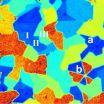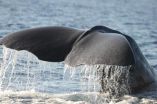(Press-News.org) A study published today in Science by researchers from the U.S. Department of Energy's Argonne National Laboratory may dramatically shift our understanding of the complex dance of microbes and minerals that takes place in aquifers deep underground. This dance affects groundwater quality, the fate of contaminants in the ground and the emerging science of carbon sequestration.
Deep underground, microbes don't have much access to oxygen. So they have evolved ways to breathe other elements, including solid minerals like iron and sulfur.
The part that interests scientists is that when the microbes breathe solid iron and sulfur, they transform them into highly reactive dissolved ions that are then much more likely to interact with other minerals and dissolved materials in the aquifer. This process can slowly but steadily make dramatic changes to the makeup of the rock, soil and water.
"That means that how these microbes breathe affects what happens to pollutants—whether they travel or stay put—as well as groundwater quality," said Ted Flynn, a scientist from Argonne and the Computation Institute at the University of Chicago and the lead author of the study.
About a fifth of the world's population relies on groundwater from aquifers for their drinking water supply, and many more depend on the crops watered by aquifers.
For decades, scientists thought that when iron was present in these types of deep aquifers, microbes who can breathe it would out-compete those who cannot. There's an accepted hierarchy of what microbes prefer to breathe, according to how much energy each reaction can theoretically yield. (Oxygen is considered the best overall, but it is rarely found deep below the surface.)
According to these calculations, of the elements that do show up in these aquifers, breathing iron theoretically provides the most energy to microbes. And iron is frequently among the most abundant minerals in many aquifers, while solid sulfur is almost always absent.
But something didn't add up right. A lot of the microorganisms had equipment to breathe both iron and sulfur. This requires two completely different enzymatic mechanisms, and it's evolutionarily expensive for microbes to keep the genes necessary to carry out both processes. Why would they bother, if sulfur was so rarely involved?
The team decided to redo the energy calculations assuming an alkaline environment—"Older and deeper aquifers tend to be more alkaline than pH-neutral surface waters," said Argonne coauthor Ken Kemner—and found that in alkaline environments, it gets harder and harder to get energy out of iron.
"Breathing sulfur, on the other hand, becomes even more favorable in alkaline conditions," Flynn said.
The team reinforced this hypothesis in the lab with bacteria under simulated aquifer conditions. The bacteria, Shewanella oneidensis, can normally breathe both iron and sulfur. When the pH got as high as 9, however, it could breathe sulfur, but not iron.
There was still the question of where microorganisms like Shewanella could find sulfur in their native habitat, where it appeared to be scarce.
The answer came from another group of microorganisms that breathe a different, soluble form of sulfur called sulfate, which is commonly found in groundwater alongside iron minerals. These microbes exhale sulfide, which reacts with iron minerals to form solid sulfur and reactive iron. The team believes this sulfur is used up almost immediately by Shewanella and its relatives.
"This explains why we don't see much sulfur at any fixed point in time, but the amount of energy cycling through it could be huge," Kemner said.
Indeed, when the team put iron-breathing bacteria in a highly alkaline lab environment without any sulfur, the bacteria did not produce any reduced iron.
"This hypothesis runs counter to the prevailing theory, in which microorganisms compete, survival-of-the-fittest style, and one type of organism comes out dominant," Flynn said. Rather, the iron-breathing and the sulfate-breathing microbes depend on each other to survive.
Understanding this complex interplay is particularly important for sequestering carbon. The idea is that in order to keep harmful carbon dioxide out of the atmosphere, we would compress and inject it into deep underground aquifers. In theory, the carbon would react with iron and other compounds, locking it into solid minerals that wouldn't seep to the surface.
Iron is one of the major players in this scenario, and it must be in its reactive state for carbon to interact with it to form a solid mineral. Microorganisms are essential in making all that reactive iron. Therefore, understanding that sulfur—and the microbe junkies who depend on it—plays a role in this process is a significant chunk of the puzzle that has been missing until now.
The study, "Sulfur-Mediated Electron Shuttling During Bacterial Iron Reduction," appears online today in the May 1 edition of Science Express and will be published in Science at the end of the month. Other authors on the study were Argonne scientists Bhoopesh Mishra (also of the Illinois Institute of Technology) and Edward O'Loughlin and Georgia Tech scientist Thomas DiChristina.
INFORMATION:
Funding for the research was provided by the U.S. Department of Energy's Office of Science. The Advanced Photon Source (APS) is also supported by the DOE's Office of Science. The team conducted X-ray analysis at the APS GeoSoilEnviroCARS beamline 13-ID-E, which is operated by the University of Chicago and jointly supported by the National Science Foundation and the DOE's Office of Science. Additional support came from the National Institutes of Health and the National Science Foundation.
The Computation Institute (CI), a joint institute of the University of Chicago and Argonne National Laboratory, is an intellectual nexus for scientists and scholars pursuing multi-disciplinary research, and a resource center for developing and applying innovative computational approaches. Founded in 1999, it is home to over 200 faculty, fellows, and staff researching complex, system-level problems in such areas as biomedicine, energy and climate, astronomy and astrophysics, computational economics, social sciences and molecular engineering. CI is home to diverse projects including the Center for Robust Decision Making on Climate and Energy Policy, the Center for Multiscale Theory and Simulation, the Urban Center for Computation and Data and Globus.
The Advanced Photon Source at Argonne National Laboratory is one of five national synchrotron radiation light sources supported by the U.S. Department of Energy's Office of Science to carry out applied and basic research to understand, predict, and ultimately control matter and energy at the electronic, atomic, and molecular levels, provide the foundations for new energy technologies, and support DOE missions in energy, environment, and national security. To learn more about the Office of Science X-ray user facilities, visit the user facilities directory.
Argonne National Laboratory seeks solutions to pressing national problems in science and technology. The nation's first national laboratory, Argonne conducts leading-edge basic and applied scientific research in virtually every scientific discipline. Argonne researchers work closely with researchers from hundreds of companies, universities, and federal, state and municipal agencies to help them solve their specific problems, advance America's scientific leadership and prepare the nation for a better future. With employees from more than 60 nations, Argonne is managed by UChicago Argonne, LLC for the U.S. Department of Energy's Office of Science. For more, visit http://www.anl.gov.
DOE's Office of Science is the single largest supporter of basic research in the physical sciences in the United States, and is working to address some of the most pressing challenges of our time. For more information, visit science.energy.gov.
Study in Science finds missing piece of biogeochemical puzzle in aquifers
Study finds a missing step in biogeochemistry of aquifers
2014-05-01
ELSE PRESS RELEASES FROM THIS DATE:
Increased drought portends lower future Midwest crop yields
2014-05-01
Increasingly harsh drought conditions in the U.S. Midwest's Corn Belt may take a serious toll on corn and soybean yields over the next half-century, according to research published today in the journal Science.
Corn yields could drop by 15 to 30 percent, according to the paper's estimates; soybean yield losses would be less severe.
North Carolina State University's Roderick Rejesus, associate professor of agricultural and resource economics and a co-author of the Science paper, says that corn and soybean yields show increasing sensitivity to drought, with yields ...
Tapah downgrades to a depression
2014-05-01
Tapah was downgraded from a tropical storm to a tropical depression and is located 239 nautical miles southeast of Iwo To. Tapah rapidly dissipated due to the effected of strong vertical windshear from the west and a sharp decreased in sea surface temperature. The storm is currently tracking northwest at 10 knots per hour and is expected to recurve to the northeast and accelerate. Maximum wave height is currently 10 feet. The storm will be monitored for signs of regeneration.
NASA captured this image of the storm with the Moderate Resolution Imaging Spectroradiometer ...
Researchers link age, general health and antidepressant use with eye disorders
2014-05-01
Abnormal binocular vision, which involves the way eyes work together as a team, increases dramatically as we age, according to research from the University of Waterloo. The study also found a correlation between this condition, general health and antidepressant use.
As many as 27 per cent of adults in their sixties have an actual binocular vision or eye movement disorder. That number rises to 38 per cent for those over age 80. About 20 per cent of the general population suffers from a binocular vision disorder, which affects depth perception and therefore may increase ...
New Hass avocado research presented at American Society for Nutrition Scientific Sessions
2014-05-01
May 1, 2014 [San Diego, CA] – New research exploring the potential effects of Hass avocado consumption on emerging cardiovascular disease (CVD) risk factors was presented at the American Society for Nutrition Scientific Sessions and Annual Meeting at Experimental Biology 2014 (EB).
Li Wang, PhD Candidate, Pennsylvania State University, presented, "Avocado consumption decreases LDL particle number and small, dense LDL cholesterol in overweight and obese subjects," at the Dietary Bioactive Components: Cardiovascular Effects of Dietary Bioactive Components session on Saturday ...
Edgy look at 2-D molybdenum disulfide
2014-05-01
The drive to develop ultrasmall and ultrafast electronic devices using a single atomic layer of semiconductors, such as transition metal dichalcogenides, has received a significant boost. Researchers with the U.S. Department of Energy (DOE)'s Lawrence Berkeley National Laboratory (Berkeley Lab) have recorded the first observations of a strong nonlinear optical resonance along the edges of a single layer of molybdenum disulfide. The existence of these edge states is key to the use of molybdenum disulfide in nanoelectronics, as well as a catalyst for the hydrogen evolution ...
Some Ohio butterflies threatened by rising temperatures
2014-05-01
The combined heat from climate change and urbanization is likely to reduce the number of eastern swallowtails and other native butterflies in Ohio and promote the spread of invasive relatives, a new study led by a Case Western Reserve University researcher shows.
Among 20 species monitored by the Ohio Lepidopterists society, eight showed significant delays in important early lifecycle events when the two factors were combined—a surprising response that may render the eight unfit for parts of the state where they now thrive.
Butterflies serve as important indicator ...
Whales hear us more than we realize
2014-05-01
RICHLAND, Wash. – Killer whales and other marine mammals likely hear sonar signals more than we've known.
That's because commercially available sonar systems, which are designed to create signals beyond the range of hearing of such animals, also emit signals known to be within their hearing range, scientists have discovered.
The sound is likely very soft and audible only when the animals are within a few hundred meters of the source, say the authors of a new study. The signals would not cause any actual tissue damage, but it's possible that they affect the behavior ...
Penn Vet research identifies compounds that control hemorrhagic viruses
2014-05-01
People fear diseases such as Ebola, Marburg, Lassa fever, rabies and HIV for good reason; they have high mortality rates and few, if any, possible treatments. As many as 90 percent of people who contract Ebola, for instance, die of the disease.
Facing this gaping need for therapies, researchers at the University of Pennsylvania School of Veterinary Medicine teamed with colleagues to focus on identifying and developing compounds that could reduce a virus' ability to spread infection. In two studies published in the Journal of Virology, the researchers have identified several ...
Hubble astronomers check the prescription of a cosmic lens
2014-05-01
Two teams of astronomers using the NASA/ESA Hubble Space Telescope have discovered three distant exploding stars that have been magnified by the immense gravity of foreground galaxy clusters, which act like "cosmic lenses". These supernovae are the first of their type ever to be observed magnified in this way and they offer astronomers a powerful tool to check the prescription of these massive lenses.
Massive clusters of galaxies act as "gravitational lenses" because their powerful gravity bends light passing through them [1]. This lensing phenomenon makes faraway objects ...
The real difference between how men and women choose their partners
2014-05-01
This news release is available in French. In Concordia's study, men responded more strongly to the "framing effect" when physical attractiveness was described.
A hamburger that's 90 per cent fat-free sounds a lot better than one with 10 per cent fat. And even when the choices are the same, humans are hard-wired to prefer the more positive option.
This is because of what's known as the "framing effect," a principle that new research from Concordia has proved applies to mate selection, too.
The study — co-authored by Concordia marketing professor Gad Saad and Wilfrid ...
LAST 30 PRESS RELEASES:
Making lighter work of calculating fluid and heat flow
Normalizing blood sugar can halve heart attack risk
Lowering blood sugar cuts heart attack risk in people with prediabetes
Study links genetic variants to risk of blinding eye disease in premature infants
Non-opioid ‘pain sponge’ therapy halts cartilage degeneration and relieves chronic pain
AI can pick up cultural values by mimicking how kids learn
China’s ecological redlines offer fast track to 30 x 30 global conservation goal
Invisible indoor threats: emerging household contaminants and their growing risks to human health
Adding antibody treatment to chemo boosts outcomes for children with rare cancer
Germline pathogenic variants among women without a history of breast cancer
Tanning beds triple melanoma risk, potentially causing broad DNA damage
Unique bond identified as key to viral infection speed
Indoor tanning makes youthful skin much older on a genetic level
Mouse model sheds new light on the causes and potential solutions to human GI problems linked to muscular dystrophy
The Journal of Nuclear Medicine ahead-of-print tip sheet: December 12, 2025
Smarter tools for peering into the microscopic world
Applications open for funding to conduct research in the Kinsey Institute archives
Global measure underestimates the severity of food insecurity
Child survivors of critical illness are missing out on timely follow up care
Risk-based vs annual breast cancer screening / the WISDOM randomized clinical trial
University of Toronto launches Electric Vehicle Innovation Ontario to accelerate advanced EV technologies and build Canada’s innovation advantage
Early relapse predicts poor outcomes in aggressive blood cancer
American College of Lifestyle Medicine applauds two CMS models aligned with lifestyle medicine practice and reimbursement
Clinical trial finds cannabis use not a barrier to quitting nicotine vaping
Supplemental nutrition assistance program policies and food insecurity
Switching immune cells to “night mode” could limit damage after a heart attack, study suggests
URI-based Global RIghts Project report spotlights continued troubling trends in worldwide inhumane treatment
Neutrophils are less aggressive at night, explaining why nighttime heart attacks cause less damage than daytime events
Menopausal hormone therapy may not pose breast cancer risk for women with BRCA mutations
Mobile health tool may improve quality of life for adolescent and young adult breast cancer survivors
[Press-News.org] Study in Science finds missing piece of biogeochemical puzzle in aquifersStudy finds a missing step in biogeochemistry of aquifers



